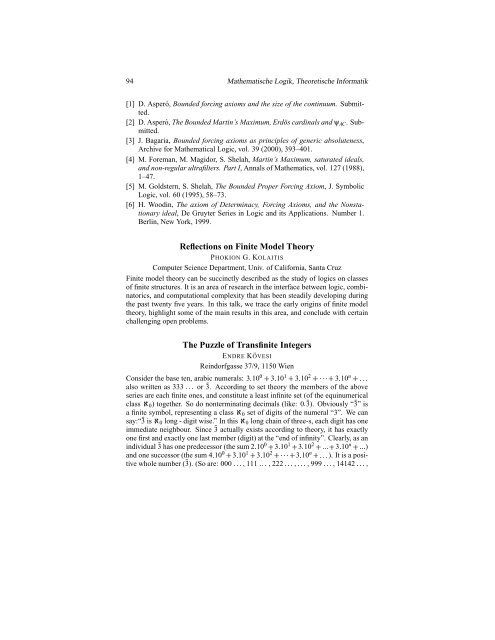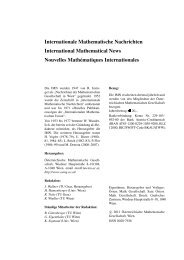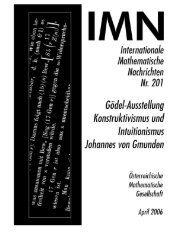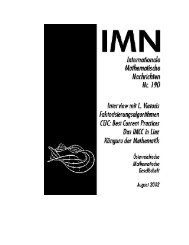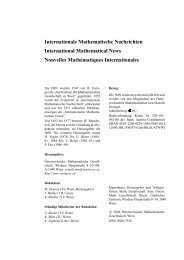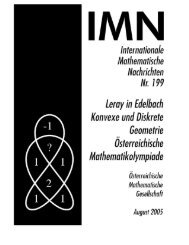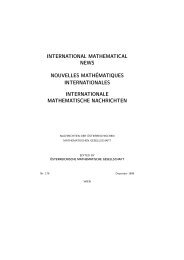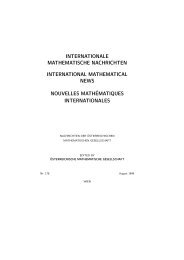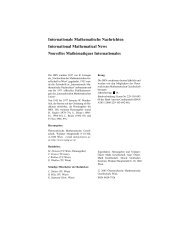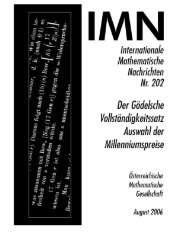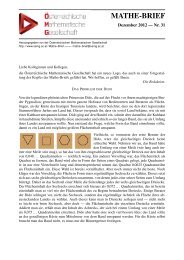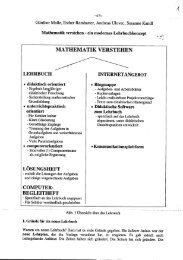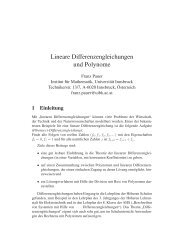Redaktion: K. Sigmund, G. Greschonig (Univ. Wien, Strudlhofgasse ...
Redaktion: K. Sigmund, G. Greschonig (Univ. Wien, Strudlhofgasse ...
Redaktion: K. Sigmund, G. Greschonig (Univ. Wien, Strudlhofgasse ...
Sie wollen auch ein ePaper? Erhöhen Sie die Reichweite Ihrer Titel.
YUMPU macht aus Druck-PDFs automatisch weboptimierte ePaper, die Google liebt.
94 Mathematische Logik, Theoretische Informatik<br />
[1] D. Asperó, Bounded forcing axioms and the size of the continuum. Submitted.<br />
[2] D. Asperó, The Bounded Martin’s Maximum, Erdös cardinals and ψAC. Submitted.<br />
[3] J. Bagaria, Bounded forcing axioms as principles of generic absoluteness,<br />
Archive for Mathematical Logic, vol. 39 (2000), 393–401.<br />
[4] M. Foreman, M. Magidor, S. Shelah, Martin’s Maximum, saturated ideals,<br />
and non-regular ultrafilters. Part I, Annals of Mathematics, vol. 127 (1988),<br />
1–47.<br />
[5] M. Goldstern, S. Shelah, The Bounded Proper Forcing Axiom, J. Symbolic<br />
Logic, vol. 60 (1995), 58–73.<br />
[6] H. Woodin, The axiom of Determinacy, Forcing Axioms, and the Nonstationary<br />
ideal, De Gruyter Series in Logic and its Applications. Number 1.<br />
Berlin, New York, 1999.<br />
Reflections on Finite Model Theory<br />
PHOKION G. KOLAITIS<br />
Computer Science Department, <strong>Univ</strong>. of California, Santa Cruz<br />
Finite model theory can be succinctly described as the study of logics on classes<br />
of finite structures. It is an area of research in the interface between logic, combinatorics,<br />
and computational complexity that has been steadily developing during<br />
the past twenty five years. In this talk, we trace the early origins of finite model<br />
theory, highlight some of the main results in this area, and conclude with certain<br />
challenging open problems.<br />
The Puzzle of Transfinite Integers<br />
ENDRE KÖVESI<br />
Reindorfgasse 37/9, 1150 <strong>Wien</strong><br />
Consider the base ten, arabic numerals: 3� 10 0 � 3� 10 1 � 3� 10 2 ��������� 3� 10 n � �����<br />
also written as 333 ����� or ¯3. According to set theory the members of the above<br />
series are each finite ones, and constitute a least infinite set (of the equinumerical<br />
class ℵ0) together. So do nonterminating decimals (like: 0� ¯3). Obviously “¯3” is<br />
a finite symbol, representing a class ℵ0 set of digits of the numeral “3”. We can<br />
say:“¯3 is ℵ0 long - digit wise.” In this ℵ0 long chain of three-s, each digit has one<br />
immediate neighbour. Since ¯3 actually exists according to theory, it has exactly<br />
one first and exactly one last member (digit) at the “end of infinity”. Clearly, as an<br />
individual ¯3 has one predecessor (the sum 2� 10 0 � 3� 10 1 � 3� 10 2 � ����� � 3� 10 n � ����� )<br />
and one successor (the sum 4� 10 0 � 3� 10 1 � 3� 10 2 ��������� 3� 10 n � ����� ). It is a positive<br />
whole number (¯3). (So are: 000 ����� , 111 ����� , 222 ����� , ����� , 999 ����� , 14142 ����� ,


